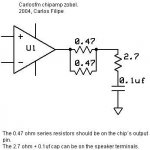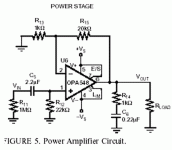Long time ago I tested zobels, because I had bad results with direct output and my Kimber 4TC speaker cables.
The amp was very picky with cables and speakers.
The best result I had was two 0.47 ohm/3w carbon resitors in series with the output.
I tested a resistor and cap to ground, with several values, and it didn't cure the problem.
What I didn't test was both.
I tested some days ago, several values, and I like it.
This time I'm not going into details, or this thread will degenerate into a big discussion.
Try it, listen and tell us what you think.
Note: by speaker terminals I mean on the amp.
This is what I have now, here it is:
The amp was very picky with cables and speakers.
The best result I had was two 0.47 ohm/3w carbon resitors in series with the output.
I tested a resistor and cap to ground, with several values, and it didn't cure the problem.
What I didn't test was both.
I tested some days ago, several values, and I like it.
This time I'm not going into details, or this thread will degenerate into a big discussion.
Try it, listen and tell us what you think.
Note: by speaker terminals I mean on the amp.
This is what I have now, here it is:
Attachments
Mad_K said:I prefer it without the 0,47R resistors, but the zobel is mandatory.
I can't detect any side effect with the series resistors, at least with the cables and speakers I tested.
Mad_K said:Place the zobel as close to the chip as possible
I said that the zobel can be on the amp's speaker terminals because it's easier for people to test it.
Ideally it should be near the chip, but on some implementations that may not be practical.
I will put it definitively near the chip.
Thanks for your feedback.

carlosfm said:No, Sheldon, that's different, nothing to do with this...
Ok, guess this is where partial knowledge is dangerous. I thought the function of the Zobel was to prevent instability of the amp due to high frequency (above audio) oscillation. If you prevent those frequencies from entering the stream, don't you circumvent the problem? Or have I got that all wrong?
thanks,
Sheldon
sam9 said:I wonder if the .47 resistors are inductive. Maybe you have inadvertently added an output inductor as well.
That's why I use carbon and not bobinated resistors.
You shouldn't use bobinated resistors on the output.
For inductance and other nasties, we have the speaker cables, speaker crossovers...
The zobel makes the amp more immune to these nasties.
Sheldon, this has to be done at the output.
I'm sorry, but the amp needs a zobel
Maybe, but which chip? The 1875 seems to really need it; the 3875 might need it with some combinations of speakers and cables.
That's why I use carbon
These carbon resistors have such a pronounced 'voice' of their own that it's absolutely impossible to distinguish the contribution of the zobel and the rose tint of the carbons. Great if you like warm and cushy sound.
analog_sa said:Maybe, but which chip? The 1875 seems to really need it; the 3875 might need it with some combinations of speakers and cables.
The LM1875 benefits, I tested it on one I have.
The LM3875 should, because I tested also with the LM3886, my power amp on my main system.
analog_sa said:These carbon resistors have such a pronounced 'voice' of their own that it's absolutely impossible to distinguish the contribution of the zobel and the rose tint of the carbons. Great if you like warm and cushy sound.
This is a starting point.
I used what I found easily, no film resistors around here at these wattages.

Even then, I prefer the carbon resistors there, because Kimber cables are mid/high capacitance, the amp plays better with the series resistors.
Use them as in any op-amp's output, to isolate the chip from capacitance.
There are several issues here.
I'm posting what works best for me.
People are free to try and, if needed, adapt to their reality.
Start with this, it's better than direct output.
carlosfm said:Long time ago I tested zobels, because I had bad results with direct output and my Kimber 4TC speaker cables.
The amp was very picky with cables and speakers.
The best result I had was two 0.47 ohm/3w carbon resitors in series with the output.
I tested a resistor and cap to ground, with several values, and it didn't cure the problem.
What I didn't test was both.
I tested some days ago, several values, and I like it.
This time I'm not going into details, or this thread will degenerate into a big discussion.
Try it, listen and tell us what you think.
Note: by speaker terminals I mean on the amp.
This is what I have now, here it is:
I have this in my original NIGC, together with a Zobel network, as well as with JoeRas suggestion of speaker return to the rail caps ground meeting point. No 0.22 ohm at the output though.
The sound is very nice and way above my commercial AV receiver amp.
I then removed the Zobel network first afterwards. I did not notice any change in the sound. Still awed by how it delivers crisp and balanced music.
Then I finally removed the Snubber circuit (the 2.7R and 0.1 cap), No change in the sound also. So I stayed in this configuration.
IMHO, these circuits (Zobel and Snubber) is only needed to protect the amp and speaker from too many variables (speaker and cable and perhaps what environment the amplifier is installed).
Since it looks like my setup is not introducing the nasty signals, and I am not likely to change setup, I decided that I have no need for it, though I provided speaker protector.
IF I will change my cable or speaker later, then I have to reintroduce again these circuits just to be safe, and remove it if I found again it is not necessary on the change.
Thank you guys. It is only now that I enjoy a truly high end music at a little cost.
thomas997 said:Around 0.05uF instead?
thanks
You can parallel them to make around 0.1uf.
the amp needs a zobel
Tried this a couple of nights ago. I am using NI OPA549 chips now,as I broke my LM1875 amp again (insert cursing here). Looked at the data sheet,which shows a zobel,but no resistors on the output. No parts values given,but I found another TI data sheet "A Complete Audio Amplifier" which shows a 1K resistor + a .22uf capacitor.Surprisingly enough I had these parts,so on they went.Sounded murky at first (new parts),but after an hour or so cleared up.These smoothened the sound out quite a bit- got rid of the bit of hardness to the sound that I didn't like with these chips. Clearer too. Thanks for the suggestion Carlos! BTW, the regulated supplies worked wonders with these chips.
Tried this a couple of nights ago. I am using NI OPA549 chips now,as I broke my LM1875 amp again (insert cursing here). Looked at the data sheet,which shows a zobel,but no resistors on the output. No parts values given,but I found another TI data sheet "A Complete Audio Amplifier" which shows a 1K resistor + a .22uf capacitor.Surprisingly enough I had these parts,so on they went.Sounded murky at first (new parts),but after an hour or so cleared up.These smoothened the sound out quite a bit- got rid of the bit of hardness to the sound that I didn't like with these chips. Clearer too. Thanks for the suggestion Carlos! BTW, the regulated supplies worked wonders with these chips.
Re: the amp needs a zobel
Are you sure of the resistor value? Most zobel resistors I have seen are just a few ohms, usually 10 in series with .1uF. The resistor has to be 1W type. Why don't you try those values and see what happen? The zobel is a filter tuned to a cut above a certrain frequency, so what you used is working, but perhaps not as a zobel should.
Carlos
mrskinny said:No parts values given,but I found another TI data sheet "A Complete Audio Amplifier" which shows a 1K resistor + a .22uf capacitor.Surprisingly enough I had these parts,so on they went.Sounded murky at first (new parts),but after an hour or so cleared up.These smoothened the sound out quite a bit- got rid of the bit of hardness to the sound that I didn't like with these chips. Clearer too.
Are you sure of the resistor value? Most zobel resistors I have seen are just a few ohms, usually 10 in series with .1uF. The resistor has to be 1W type. Why don't you try those values and see what happen? The zobel is a filter tuned to a cut above a certrain frequency, so what you used is working, but perhaps not as a zobel should.
Carlos
carlosfm said:
You can parallel them to make around 0.1uf.
Yeah I guess I will, but it would mean I have to buy more caps..
I thought I set a limit on this project
I thought the 1K value seemed high too. I looked at the data sheets for a few other chips, which show low value resistors- 1R, 2.2R,etc. Looked at the sheet that I got this from again, but it does say 1K. I have (hopefully) included this below. It could be a misprint, but this was shown twice the same way on the datasheet.
Attachments
- Status
- This old topic is closed. If you want to reopen this topic, contact a moderator using the "Report Post" button.
- Home
- Amplifiers
- Chip Amps
- I'm sorry, but the amp needs a zobel

